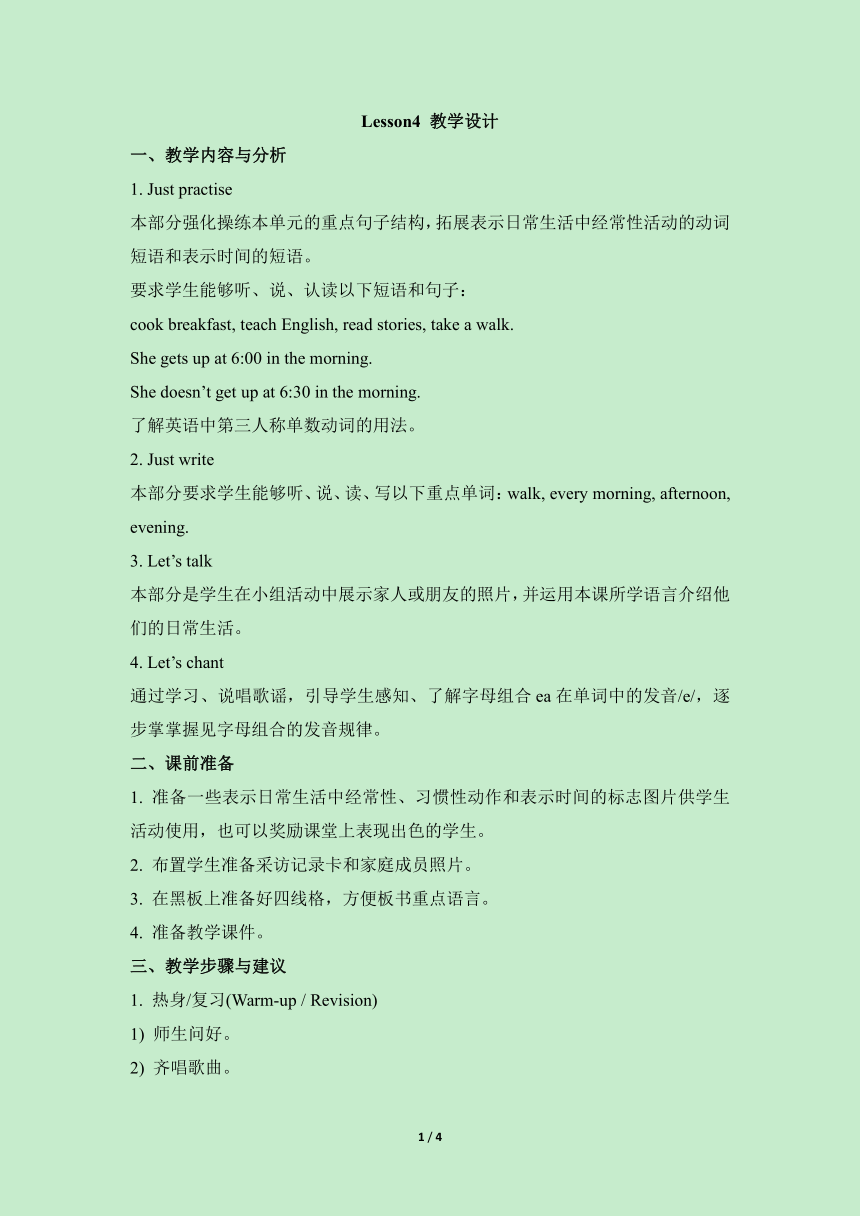
Lesson4 教学设计 一、教学内容与分析 1. Just practise 本部分强化操练本单元的重点句子结构,拓展表示日常生活中经常性活动的动词短语和表示时间的短语。 要求学生能够听、说、认读以下短语和句子: cook breakfast, teach English, read stories, take a walk. She gets up at 6:00 in the morning. She doesn’t get up at 6:30 in the morning. 了解英语中第三人称单数动词的用法。 2. Just write 本部分要求学生能够听、说、读、写以下重点单词:walk, every morning, afternoon, evening. 3. Let’s talk 本部分是学生在小组活动中展示家人或朋友的照片,并运用本课所学语言介绍他们的日常生活。 4. Let’s chant 通过学习、说唱歌谣,引导学生感知、了解字母组合ea在单词中的发音/e/,逐步掌掌握见字母组合的发音规律。 二、课前准备 1. 准备一些表示日常生活中经常性、习惯性动作和表示时间的标志图片供学生活动使用,也可以奖励课堂上表现出色的学生。 2. 布置学生准备采访记录卡和家庭成员照片。 3. 在黑板上准备好四线格,方便板书重点语言。 4. 准备教学课件。 三、教学步骤与建议 1. 热身/复习(Warm-up / Revision) 1) 师生问好。 2) 齐唱歌曲。 播放英文歌曲Good morning,师生齐唱。 3) 自由问答。 When do you get up every morning Look at Mary. She is a lazy girl. Guess, when does she get up Do you have a lazy friend When does your friend go to school When does she / he read books Does she / he often play ball games 2. 新课呈现(Presentation ) 1) 呈现情景。 教师说:Today, let’s go on talking our daily life. 2) 复现课文,巩固学习She gets up at 6:30 in the morning.等表达日常生活的句子,逐步熟悉英语中第三人称单数动词的用法。 教师引导学生介绍家人的日常生活:Would you like to tell us your mother’s / father’s daily life (1) 学生两人一组,利用自己准备的英文日常生活时间表展开讲述活动。 (2) 各组选派学生代表进行展示。 (3) 教师请其他同学认真听,并进行记录。 (4) 教师让学生说说自己父母日常生活时间与其他同学有什么不同。例如: 学生A: My mother gets up at 7:00 in the morning. My mother cooks breakfast at 7:15. My mother goes to work at 7:30. 学生B: My mother gets up at 7:15 in the morning. My mother cooks breakfast at 7:20. My mother goes to work at 7:40. 教师可以顺势引导学生用否定形式表达:She/He doesn’t get up at 7:00 in the morning. 3) 在与学生交流中,必要时教师可以适当补充一些日常活动的短语,丰富学生的语言。如:play football, play the piano, see a film, go shopping, mop the floor, wash dishes等。 3. 趣味操练(Practise) 1) 教师说:Let’s talk in pairs. Look! This is our family members’ timetable.用课件呈现时间轴和相关活动短语及图片,让学生两人一组操练主要句子,教师适时板书重点单词 walk, every morning, afternoon, evening。 2) Let’s talk 教师让学生在小组内展示家人或好朋友的照片,运用本课所学语言介绍他们的生活、学习情况。也可以做成一个小组活动或者个人采访的活动,教师提出采访要求后,学生可以设计好自己的采访表格,选择采访对象,并用What’s her/ his name When does she /he ... Does he / she like… Does he / she often ... 等进行提问。通过小组合作的方式,自然运用所学知识。 3) Let’s chant T: Look! My friend Ted is coming. What’s wrong with him 学习学生用书第7页的Let’s chant,通过歌谣感知字母组合ea在单词中的读音/e/,让学生说一说含有字母ea的 ... ...
~~ 您好,已阅读到文档的结尾了 ~~

